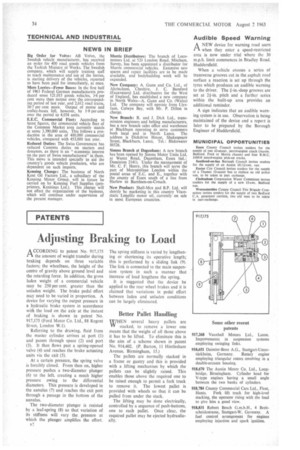Adjusting Braking to Load
Page 36

If you've noticed an error in this article please click here to report it so we can fix it.
A CCORDING to patent No. 917,175 1-1 the amount of weight transfer during braking depends on three variable factors; the wheelbase, the height of the centre of gravity above ground level and the retarding force. In addition, the gross laden weight of a commercial vehicle may be 250 per cent. greater than the unladen weight. The brake pedal effort may need to be varied in proportion. A device for varying the output pressure in a hydraulic brake system in accordance with the load on the axle at the instant of braking is shown in patent No. 917,175 (Ford Motor Co. Ltd., 88 Regent Street, London W.1).
Referring to the drawing, fluid from the master cylinder arrives at port (1) and passes through space (2) and port (3). It then flows past a spring-opened valve (4) and reaches the brake actuating units via the exit (5).
At a certain pressure, the spring valve is forcibly closed. From then on, higher pressure pushes a two-diameter plunger (6) to the left, creating a much higher pressure owing to the differential diameters. This pressure is developed in the annulus (7) and reaches (he exit port through a passage in the bottom of the annulus.
The two-diameter plunger is resisted by a leaf-spring (8) so that variation of its stiffness will vary the pressure at which the plunger amplifies the effort. The spring stiffness is varied by lengthening or shortening its operative length; this is performed by a sliding link (9). The link is connected to the main suspension system in such a manner that increase of load lengthens the spring.
It is suggested that the device be applied to the rear wheel brakes and it is claimed that variations in pedal effort between laden and unladen conditions can be largely eliminated.




























































































